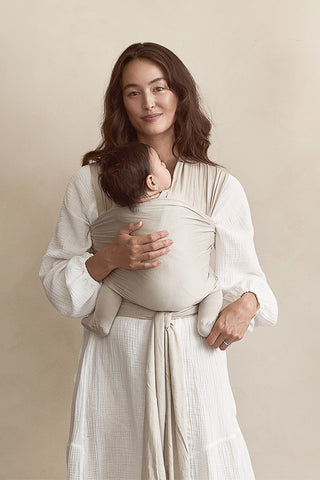If you’re anything like I was, you had seen plenty of swaddled babies before having your own and never thought about the how or why behind it—aside from the fact that it makes for very cute photos.
As it turns out (and as I learned after having three babies of my own), there’s more to swaddling than getting share-worthy pictures of peaceful newborn burritos. Read on to find out how to swaddle a baby and the why behind it this age-old practice.
What is swaddling?
An ancient technique, swaddling involves snugly wrapping a baby in a cloth or blanket. You can start swaddling baby as soon as they make their way earthside—and you'll find that most hospitals and birthing centers will swaddle baby after they're born and have skin-to-skin time.
Why swaddle a baby?
After spending nine months all warm and cozy in mama’s womb, having space and freedom to move can trigger a baby’s startle response—that innate Moro reflex where they suddenly arch their back and fling out their arms and legs. Swaddling mimics the experience of being in the womb by keeping those little limbs in place, providing comfort and a sense of security to newborn babies.
How to pick a swaddle
A swaddle blanket should be light and breathable to prevent overheating and promote safe sleep. The Solly Swaddle is made from the same breathable, buttery-soft fabric as the Solly Wrap, making it an ideal option for swaddling year-round. It’s also generously-sized for easy use and readily doubles as a lovey or toddler blanket as your child ages. (I've had lots of mamas tell me they use it as a breathable nursing cover, too!)
How to swaddle a baby
Unless you’re a baby nurse or you spend your days wrapping burritos, a good swaddle job can be tough to nail at first. Be gentle with yourself and keep at it. As with any new skill, practice makes perfect. Our Solly Swaddle tutorials walk you through three different swaddling techniques, step by step.
And good news—if you’ve struggled with how to swaddle using a blanket in the past, you’ll find that the Solly Swaddle isn’t like other blankets. It’s designed with naturally stretchy TENCEL™ Modal fabric and a larger size to make it easy to achieve that stay-put swaddle, especially when paired with our how-to videos for guidance.
Common swaddling mistakes
1. Swaddling too tight
You want baby's swaddle to be snug, but not so tight that it restricts their breathing and movement. The swaddle should be wrapped in a way that keeps baby’s arms pinned at their sides while allowing them to breathe easily and scrunch up their legs. Wrapping baby’s legs looser than their torso allows them to bend their knees and hips freely, allowing proper hip development and growth.
2. Swaddling too loose
While you want to avoid wrapping baby too tight, you'll also want to avoid wrapping too loose. A swaddle that isn’t wrapped tightly enough could unravel and pose a suffocation hazard. Wrap the swaddle snugly so it doesn't come undone.
3. Swaddling too high
A baby’s neck and face should never be covered by a swaddle to avoid suffocation. When wrapping, keep the top edge of the swaddle down and away from baby’s face and chin.
How to dress a baby underneath a swaddle
Temperature regulation is the most important factor when it comes to dressing your baby to be swaddled. Dressing a baby too warm creates a risk for overheating, while a baby who's too cold may experience difficulty falling or staying asleep. A good rule of thumb is to dress a baby in one more layer of clothing than you would wear in the same room. For example, if you’re comfortable in a shirt and pants, you might dress your baby in a bodysuit under their swaddle. (Remember, the swaddle counts as a layer.) As always, keep an eye out for signs that your baby is too warm, such as flushed cheeks.
Swaddle-safe sleeping
Always practice safe sleeping guidelines when baby is swaddled. Put baby to sleep on their back (never on their side or stomach) and keep their crib or bassinet free from loose blankets, pillows, and stuffed animals.
When to stop using a swaddle
You should discontinue the use of a swaddle as soon as baby starts showing signs of rolling over (typically around the 4-month mark). Before then, you might consider preparing for a transition out of the swaddle with a gradual approach—swaddling with one arm out, then both arms out, then removing the swaddle altogether.
That's a wrap!
Remember: Behind every perfectly wrapped baby burrito is someone who has wrapped and re-wrapped their baby (and re-wrapped again). Keep practicing, be patient, and you’ll be a swaddling pro in no time! And if you need extra guidance, you can always schedule a free consultation with me.















